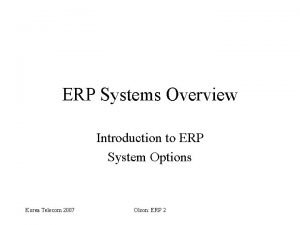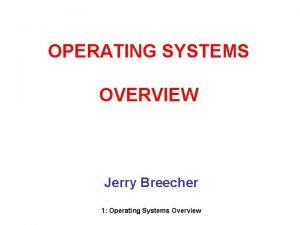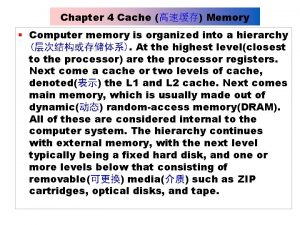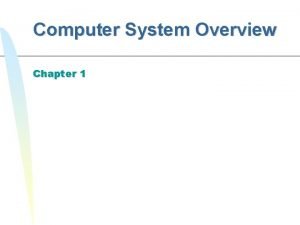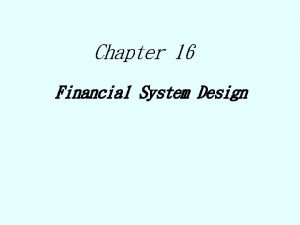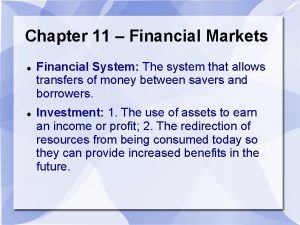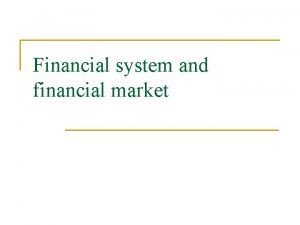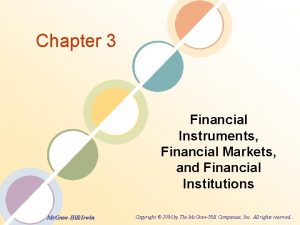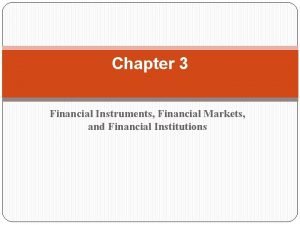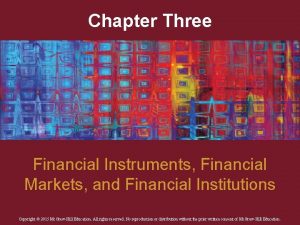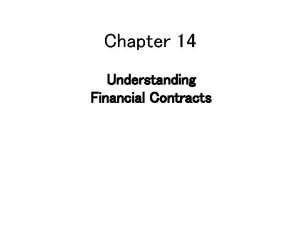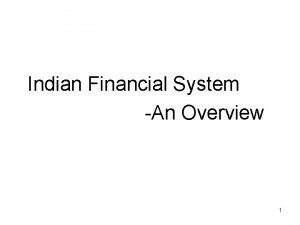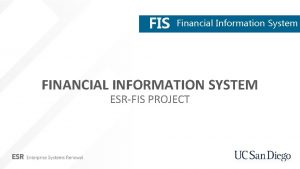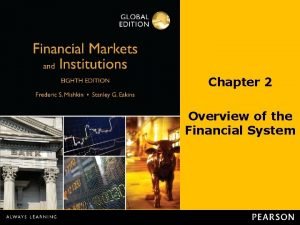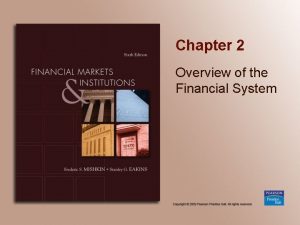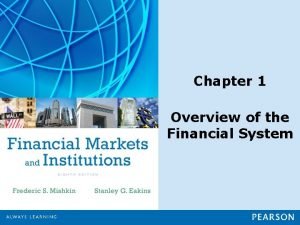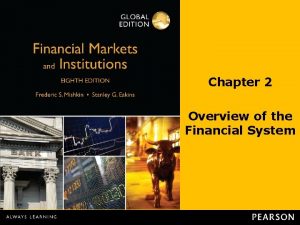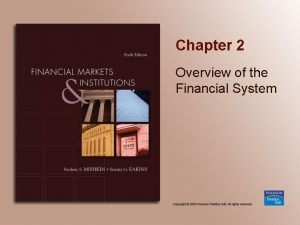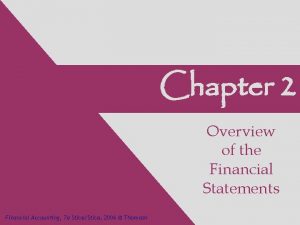OVERVIEW OF THE FINANCIAL SYSTEM Chapter 2 AN














































- Slides: 46

OVERVIEW OF THE FINANCIAL SYSTEM Chapter 2

AN OVERVIEW OF THE FINANCIAL SYSTEM Primary Function of the Financial System is Financial Intermediation 2. 2

FUNCTION OF FINANCIAL MARKETS Channels funds from person or business without investment opportunities (i. e. , “Lender-Savers”) to one who has them (i. e. , “Borrower-Spenders”) Improves Critical economic efficiency for producing an efficient allocation of capital, which contributes to higher production and efficiency of overall economy

FUNCTION OF FINANCIAL MARKETS Well-functioning markets improve the well being of consumers by allowing them to time their purchases better

FINANCIAL MARKETS FUNDS TRANSFEREES Lender-Savers 1. Households 2. Business firms 3. Government 4. Foreigners Borrower-Spenders 1. Business firms 2. Government 3. Households 4. Foreigners

METHODS OF FUNDS TRANSFER 1. Direct financing 2. Indirect financing

DIRECT FINANCING Borrowers borrow directly from lenders in financial markets by selling financial instruments which are claims on the borrower’s future income or assets

DIRECT FINANCE Securities are assets for the person who buys them They are liabilities for the individual or firm that issues them

INDIRECT FINANCE • Borrowers borrow indirectly from lenders via financial intermediaries (established to source both loanable funds and loan opportunities) by issuing financial instruments which are claims on the borrower’s future income or assets

FUNCTION OF FINANCIAL MARKETS

IMPORTANCE OF FINANCIAL MARKETS This is important. For example, if you save $1, 000, but there are no financial markets, then you can earn no return on this—might as well put the money under your mattress. However, if a carpenter could use that money to buy a new saw (increasing her productivity), then she’d be willing to pay you some interest for the use of the funds.

IMPORTANCE OF FINANCIAL MARKETS § § Financial markets are critical for producing an efficient allocation of capital, allowing funds to move from people who lack productive investment opportunities to people who have them. Financial markets also improve the wellbeing of consumers, allowing them to time their purchases better.

CLASSIFICATIONS OF FINANCIAL MARKETS Debt Markets Short-term (maturity < 1 year) – the Money Market Long-term (maturity > 10 year) – the Capital Market Medium-term (maturity >1 and < 10 years) 2. 13 © 2008 Pearson Education Canada

DEBT INSTRUMENT A contractual agreement by the borrower to pay the holder of the instrument fixed dollar amounts at regular intervals until a specified date (the maturity date) when a final payment is made.

COMMON STOCK Claims to share in the net income and the assets of the business Often make periodic payments called dividends Long-term as no maturity date Residual claimant

CLASSIFICATION OF FINANCIAL MARKETS 1. Primary market 2. Secondary market

PRIMARY MARKET New security, bond or stock, issues sold to initial buyers by the corporation or government agency borrowing funds Financial institution that facilitates is investment bank Does underwriting securities Guarantees a price for the corporation’s securities and then sells them to the public 2. 17 © 2008 Pearson Education Canada

SECONDARY MARKET Securities previously issued are bought and sold 2. 18 © 2008 Pearson Education Canada

SECONDARY MARKETS Even though firms don’t get any money, per se, from the secondary market, it serves two important functions: Provide liquidity, making it easy to buy and sell the securities of the companies Establish a price for the securities

SECONDARY MARKETS –ORGANIZATION OF EXCHANGES 1. Organize exchanges where buyers and sellers of securities (or their brokers or agents) meet in one central location to conduct trades 2. Over the counter market: Dealers at different locations who have an inventory of securities stand ready to buy and sell securities over the counter 2. 20 © 2008 Pearson Education Canada

SECONDARY MARKETS Security brokers and dealers are crucial to well functioning secondary markets Brokers are agents of investors who match buyers with sellers of securities Dealers link buyers and sellers by buying and selling securities at stated prices

MONEY AND CAPITAL MARKETS Another way of distinction: Money market: financial market in which only shortterm debt instruments with maturity of one year or less are traded Capital market: market in which debt instruments with a maturity of more than one year and equity instruments are traded

FUNCTION OF FINANCIAL INTERMEDIARIES: INDIRECT FINANCE Instead of savers lending/investing directly with borrowers, a financial intermediary (such as a bank) plays as the middleman: § the intermediary obtains funds from savers § the intermediary then makes loans/investments with borrowers

FUNCTION OF FINANCIAL INTERMEDIARIES: INDIRECT FINANCE § § § This process, called financial intermediation, is actually the primary means of moving funds from lenders to borrowers. More important source of finance than securities markets (such as stocks) Needed because of transactions costs, risk sharing, and asymmetric information

TRANSACTION COSTS 1. Financial intermediaries make profits by reducing transactions costs 2. Reduce transactions costs by developing expertise and taking advantage of economies of scale 3. Provide liquidity services

TRANSACTION COSTS A financial intermediary’s low transaction costs mean that it can provide its customers with liquidity services 1. Banks provide depositors with checking accounts that enable them to pay their bills easily 2. Depositors can earn interest on checking and savings accounts and yet still convert them into goods and services whenever necessary

RISK SHARING FI’s low transaction costs allow them to reduce the exposure of investors to risk, through a process known as risk sharing � FIs create and sell assets with lesser risk to one party in order to buy assets with greater risk from another party � This process is referred to as asset transformation, because in a sense risky assets are turned into safer assets for investors

RISK SHARING § Financial intermediaries also help by providing the means for individuals and businesses to diversify their asset holdings. § Low transaction costs allow them to buy a range of assets, pool them, and then sell rights to the diversified pool to individuals.

FUNCTION OF FINANCIAL INTERMEDIARIES: INDIRECT FINANCE § Another reason FIs exist is to reduce the impact of asymmetric information. § One party lacks crucial information about another party, impacting decision-making. § We usually discuss this problem along two fronts: adverse selection and moral hazard.

FUNCTION OF FINANCIAL INTERMEDIARIES: INDIRECT FINANCE § Adverse Selection 1. Before transaction occurs 2. Potential borrowers most likely to produce adverse outcome are ones most likely to seek a loan 3. Similar problems occur with insurance where unhealthy people want their known medical problems covered

ASYMMETRIC INFORMATION: ADVERSE SELECTION AND MORAL HAZARD Moral Hazard 1. After transaction occurs 2. Hazard that borrower has incentives to engage in undesirable (immoral) activities making it more likely that won’t pay loan back 3. Again, with insurance, people may engage in risky activities only after being insured 4. Another view is a conflict of interest

ASYMMETRIC INFORMATION: ADVERSE SELECTION AND MORAL HAZARD § Financial intermediaries reduce adverse selection and moral hazard problems, enabling them to make profits. § Because of their expertise in screening and monitoring, they minimize their losses, earning a higher return on lending and paying higher yields to savers.

TYPES OF FINANCIAL INTERMEDIARIES

TYPES OF FINANCIAL INTERMEDIARIES

REGULATION OF FINANCIAL MARKETS § Main Reasons for Regulation 1. Increase Information to Investors Decreases adverse selection and moral hazard problems SEC forces corporations to disclose information 2. Ensuring the Soundness of Financial Intermediaries Prevents financial panics Chartering, reporting requirements, restrictions on assets and activities, deposit insurance, and anti-competitive measures 3. Improving Monetary Control Reserve requirements Deposit insurance to prevent bank panics

REGULATION REASON: INCREASE INVESTOR INFORMATION Asymmetric information in financial markets means that investors may be subject to adverse selection and moral hazard problems that may hinder the efficient operation of financial markets and may also keep investors away from financial markets Regulation takes care of this aspect

REGULATION REASON: INCREASE INVESTOR INFORMATION Such government regulation can reduce adverse selection and moral hazard problems in financial markets and increase their efficiency by increasing the amount of information available to investors.

REGULATION REASON: ENSURE SOUNDNESS OF FINANCIAL INTERMEDIARIES § § Asymmetric information makes it difficult to evaluate whether the financial intermediaries are sound or not. Can result in panics, bank runs, and failure of intermediaries.

REGULATION REASON: ENSURE SOUNDNESS OF FINANCIAL INTERMEDIARIES (CONT. ) § To protect the public and the economy from financial panics, the government has implemented six types of regulations: ─ Restrictions on Entry ─ Disclosure ─ Restrictions on Assets and Activities ─ Deposit Insurance ─ Limits on Competition ─ Restrictions on Interest Rates

REGULATION: RESTRICTION ON ENTRY § Restrictions on Entry Regulators have created very tight regulations as to who is allowed to set up a financial intermediary ─ Individuals or groups that want to establish a financial intermediary, such as a bank or an insurance company, must obtain a charter from the state or the federal government ─ Only if they are upstanding citizens with impeccable credentials and a large amount of initial funds will they be given a charter. ─

REGULATION: DISCLOSURE § Disclosure Requirements § There are stringent reporting requirements for financial intermediaries Their bookkeeping must follow certain strict principles, ─ Their books are subject to periodic inspection, ─ They must make certain information available to the public. ─

REGULATION: RESTRICTION ON ASSETS AND ACTIVITIES § Restrictions on the activities and assets of intermediaries helps to ensure depositors that their funds are safe and that the bank or other financial intermediary will be able to meet its obligations. � Intermediary are restricted from certain risky activities � And from holding certain risky assets, or at least from holding a greater quantity of these risky assets than is prudent

REGULATION: DEPOSIT INSURANCE § The government can insure people depositors to a financial intermediary from any financial loss if the financial intermediary should fail § The Federal Deposit Insurance Corporation (FDIC) insures each depositor at a commercial bank or mutual savings bank up to a loss of $250, 000 per account.

REGULATION: LIMITS ON COMPETITION § Although the evidence that unbridled competition among financial intermediaries promotes failures that will harm the public is extremely weak, it has not stopped the state and federal governments from imposing many restrictive regulations § In the past, banks were not allowed to open up branches in other states, and in some states banks were restricted from opening additional locations

REGULATION: RESTRICTIONS ON INTEREST RATES § § § Competition has also been inhibited by regulations that impose restrictions on interest rates that can be paid on deposits These regulations were instituted because of the widespread belief that unrestricted interest-rate competition helped encourage bank failures during the Great Depression Later evidence does not seem to support this view, and restrictions on interest rates have been abolished

REGULATION REASON: IMPROVE MONETARY CONTROL § § § Because banks play a very important role in determining the supply of money (which in turn affects many aspects of the economy), much regulation of these financial intermediaries is intended to improve control over the money supply One such regulation is reserve requirements, which make it obligatory for all depository institutions to keep a certain fraction of their deposits in accounts with the Federal Reserve System (the Fed), the central bank in the United States Reserve requirements help the Fed exercise more precise control over the money supply
 Financial intermediaries
Financial intermediaries Chapter 1 an overview of financial management
Chapter 1 an overview of financial management Chapter 1 overview of financial statement analysis
Chapter 1 overview of financial statement analysis Overview of financial management
Overview of financial management The commonly accepted goal of the mnc is to:
The commonly accepted goal of the mnc is to: Overview of financial management
Overview of financial management Introduction to erp systems
Introduction to erp systems Introduction to content management systems
Introduction to content management systems Computerized accounting information system
Computerized accounting information system Overview of the digestive system
Overview of the digestive system Sap ps overview
Sap ps overview Operating systems overview
Operating systems overview Abstract for gym management system
Abstract for gym management system Anatomy of the digestive system exercise 38
Anatomy of the digestive system exercise 38 Computer memory system overview
Computer memory system overview Computer memory system overview
Computer memory system overview British school system overview
British school system overview British school system overview
British school system overview System analysis
System analysis System design overview
System design overview System overview sample
System overview sample Lpi
Lpi 3 lobes lung
3 lobes lung Computer system overview
Computer system overview Chapter 26 saving investment and the financial system
Chapter 26 saving investment and the financial system Hình ảnh bộ gõ cơ thể búng tay
Hình ảnh bộ gõ cơ thể búng tay Frameset trong html5
Frameset trong html5 Bổ thể
Bổ thể Tỉ lệ cơ thể trẻ em
Tỉ lệ cơ thể trẻ em Chó sói
Chó sói Glasgow thang điểm
Glasgow thang điểm Hát lên người ơi alleluia
Hát lên người ơi alleluia Các môn thể thao bắt đầu bằng từ đua
Các môn thể thao bắt đầu bằng từ đua Thế nào là hệ số cao nhất
Thế nào là hệ số cao nhất Các châu lục và đại dương trên thế giới
Các châu lục và đại dương trên thế giới Công thức tính thế năng
Công thức tính thế năng Trời xanh đây là của chúng ta thể thơ
Trời xanh đây là của chúng ta thể thơ Mật thư tọa độ 5x5
Mật thư tọa độ 5x5 Làm thế nào để 102-1=99
Làm thế nào để 102-1=99 độ dài liên kết
độ dài liên kết Các châu lục và đại dương trên thế giới
Các châu lục và đại dương trên thế giới Thơ thất ngôn tứ tuyệt đường luật
Thơ thất ngôn tứ tuyệt đường luật Quá trình desamine hóa có thể tạo ra
Quá trình desamine hóa có thể tạo ra Một số thể thơ truyền thống
Một số thể thơ truyền thống Cái miệng nó xinh thế chỉ nói điều hay thôi
Cái miệng nó xinh thế chỉ nói điều hay thôi Vẽ hình chiếu vuông góc của vật thể sau
Vẽ hình chiếu vuông góc của vật thể sau Biện pháp chống mỏi cơ
Biện pháp chống mỏi cơ






